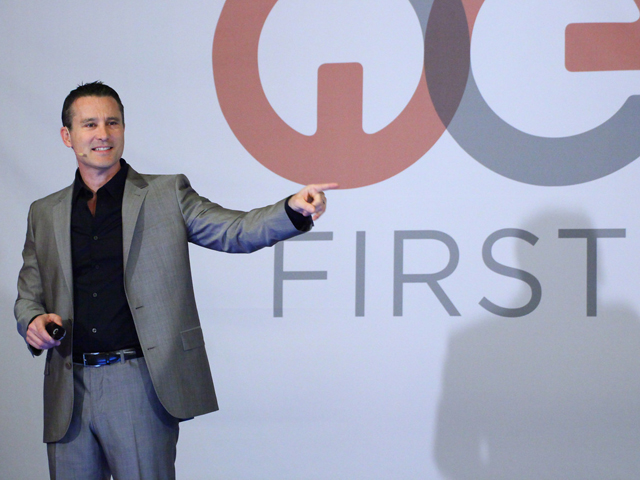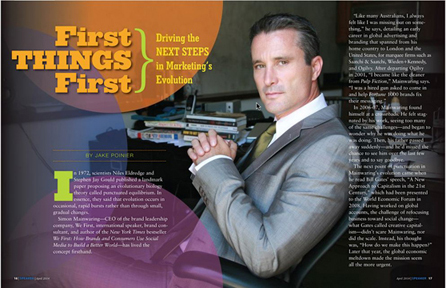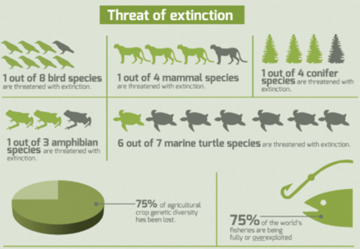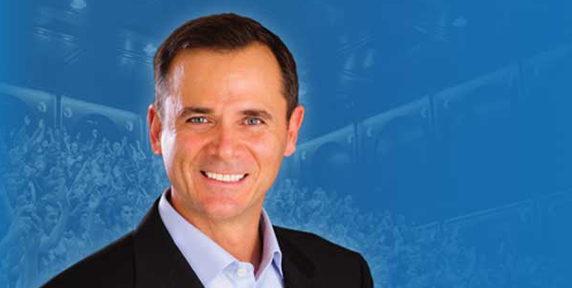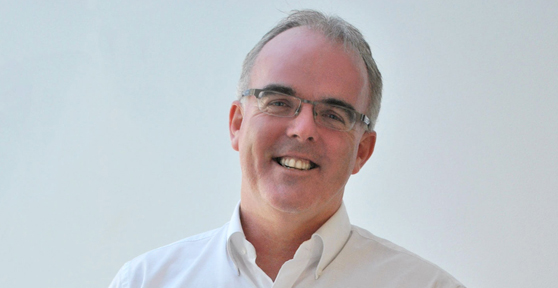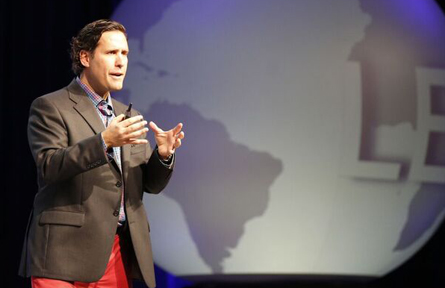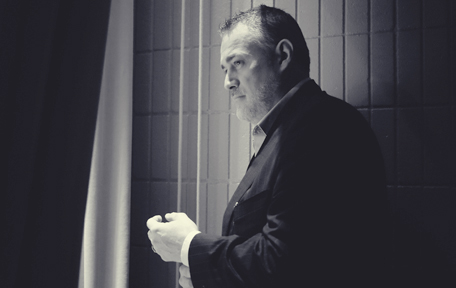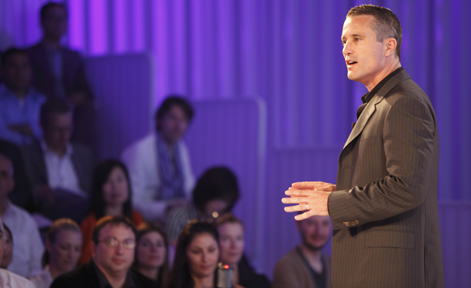
Purpose-Driven Branding with Simon Mainwaring
| A brand must be a mission with a company, not a company with a mission. | |
| |
 | You are considered one of the world's foremost experts on branding and social media, what are some of trends you see emerging in the next ten years? |
 | To answer this question, we need to mention a few assumptions. Thanks to the intersection of the web, social media, and smart phones, the consumer audience we are now speaking to is incredibly well-informed, media savvy and constantly connected to their friends, family and communities.
At the same time, social technologies have facilitated an ongoing, real-time dialogue that has reversed the traditional direction of conversations between brands and their customers. By that I mean consumers are now driving the conversation and brands are leading by listening. With these two considerations in mind, it’s important to recognize three principles that will define the future branding and the use of social media: 1. First, the future of profit is purpose. That’s because the consumer base for any brand is now very aware of the social crises we face and are looking to brands to be part of the solution. 2. Second, a brand must be the chief celebrant, not celebrity, of its customer community. Only then can a brand talk to consumers in a way that they will actually listen and earn goodwill in return. 3. Third, a brand must be a mission with a company, not a company with a mission. This shift in focus empowers brands to lead cultural conversations that are relevant and meaningful to consumers’ lives, and inspire consumers to work with a brand to build its business and positive impact. |
 | What are some of the main challenges and opportunities faced today in social branding? |
 | When it comes to social branding there are two key challenges.
First, a company must have a clear definition of its brand and an authentic desire to have a positive impact on the world. For many brands this is a challenge because their motives and marketing have become so fractured and they’re also fearful of leading an authentic conversation across social media in case it invites too much scrutiny, accountability and, potentially, a PR crisis. Second, brands also face the challenge of managing real-time messaging across a wide array of social media channels where each has a specific focus and style of engagement. To do this well, a brand must invest in leadership, marketing and employee training in social storytelling. To address these two main challenges, companies must take these three steps: 1. Invest in defining their brand and the positive difference it wants to make in the world. 2. Invest in training that allows its marketing team, employee advocates and customer community to speak on the company’s behalf with confidence. 3. Commit to leading a cultural conversation while recognizing this requires greater accountability, more transparency and a higher tolerance for risk. |
| Invite your community to co-own, co-author and co-create the brand story and the positive impact the company has on the world. | |
| |
 | How do you suggest organizations embrace social media, branding and marketing to have a positive impact on their communities as well as profits? |
 | For several decades there’s been a false separation between profit and purpose. Typically, you would find the good work of a company separated out as foundation, sustainability or cause marketing efforts. Fortunately–and unfortunately–the social crises we now face have focused consumer attention on brands and the positive or negative impact they are having, especially in the case of Millennial and Gen Z generations.
With this in mind, the most effective way to leverage branding in social media to have a positive impact on communities and profits, is as follows: 1. Clearly define what the company stands for and the difference it is going to make in the world in a way that differentiates it within its industry or category. 2. Invite your community to co-own, co-author and co-create the brand story and the positive impact the company has on the world. This can range from inviting them to discuss a topic on social media, to sharing social media content, to partnering with the brand through donations or actions to have a positive benefit. 3. Each marketing tactic must consistently reinforce the same message of positive impact. Too often brands take a tactical approach to social media which means their various efforts never ladder up to something, and therefore never generate a long-term impact or motivate long-term engagement by consumers. |
 | Would you please share three tips on how to build consumer engagement? |
 | When it comes to creating, maintaining and building consumer engagement, a brand needs to accept that it must now be a ‘community architect’. With this in mind, here are three tips to building a self-sustaining customer community.
First, recognize that companies do not build brands any more, consumers do. This simple observation will fundamentally transform how you approach what you say and how you say it. Second, brands must stop talking about the good work they do in a self-directed way but rather talk about the positive impact on consumers’ lives and the positive impact they themselves have on others. This is when a brand will create content or messaging that consumers want to share, rather than simply reject it as more self-serving advertising. Third, when a brand does reach out to consumers and attains engagement, it must quickly upgrade that engagement and reward its consumer base for staying engaged. Done correctly, a brand can then position each tactic as a way to upgrade its consumer engagement to the next tactic, and over time build a self-sustaining community that will take on a life of its own. |
| If an organization wants to foster social good, the first place to start is inside the company rather than outside. | |
| |
 | How do organizations foster "social good"? |
 | If an organization wants to foster social good, the first place to start is inside the company rather than outside. Without ensuring that the internal culture of a company is in place, it is easy for marketing or cause marketing efforts to come across as inauthentic. What’s more, a brand could be accused of “cause-washing” or “green-washing” and face a costly PR crisis.
Instead, a brand must look towards heritage and ask itself three key questions: The answer to these three questions will reveal key themes and a commitment that speaks to the heart of the brand and its promise to the world. Once identified, leadership must communicate that commitment to its employees first and give them ways to participate in realizing social impact. Only then should a brand go out to the world and market its commitment to social change in a way that is community-facing rather than self-serving. Done in this order, a brand’s commitment to social good can then be received as authentic. Here, there is a critical alignment between leadership, employees and marketing in terms of what the brand is saying and what it is doing both inside and outside of the company. |
 | What tools can organizations use to build a self-sustaining customer community? |
 | Building a self-sustaining customer community requires three types of tools:
The first are listening tools so that a brand can start to understand what its target audiences is saying, what they care about, and where they are saying it. Listening tools can range from free options such as Hootsuite to enterprise level platforms such as Radian6. The second type of tool that brands require is one that allows employees to communicate and engage around the brand’s purpose, values and story. An example of such a tool is Yammer, which is an internal social network that facilitates employees’ engagement to talk and share ideas with each other in the context of company privacy and protection. The third type of tool is one that allows the brand to lead a cultural conversation. To do so, a brand must be able to share messaging and content in channel specific ways in both real and scheduled formats. Again, free tools like Tweetdeck are a great starting point and there are more sophisticated enterprise options such a Sprinklr. Used together to listen to consumers, drive employee engagement and lead a cultural conversation, these tools can be incredibly effective at inspiring employees to become brand advocates and for consumers to use their own social media channels to amplify the brand story. |
| One of the very first places we start our work with clients is defining the brand story in simple and scalable terms that can make an emotional connection and has universal appeal. | |
| |
 | How have your clients been able to scale social change using social technologies? |
 | Scaling social change is the function of two powerful ingredients:
The first is effective storytelling. For that to be possible, the brand must have defined a brand story that is at once universal and personal, and one that can be told on global and local levels equally well. Only then will the story have the necessary versatility to be able to speak in a very personal way to consumers while at the same time creating a large-scale vision that everyone can aspire to. A few well-known examples include Unilever’s “Sustainable Living,” IBM’s “Smarter Planet” and Starbucks’ “Shared Planet.” All three examples exhibit the necessary compressed complexity to be scalable around the world and across different channels so that the brand can increase its social impact. One of the very first places we start our work with clients is defining the brand story in simple and scalable terms that can make an emotional connection and has universal appeal. The second essential component is technology and training. Typically, in order to empower a brand to share its story in a scalable way, we help them define their brand story, train them in social storytelling best practices, and then work with them to define a social marketing plan that shows them how to use social technologies inside and outside the company. As a summary, the four key stages in our work with clients that empower them to scale social change in ways that build their business are: 1. Story definition (brand story and social purpose) |
 | What is "strategic storytelling" and how does it humanize a brand? |
 | Strategic storytelling is simply a marketing practice in which the story of a brand is framed to meet its business, communications and social impact goals.
To achieve this a brand must look at marketing from a unique, and perhaps counterintuitive, starting point: what positive impact does the brand want to have on the world (rather than how does it generate profit)? Implicit within this is the recognition that brand purpose is now a business driver, given shifts in culture, technology and demographics that have made the positive impact of a brand a competitive advantage. This marketing practice also implies a commitment to consistent, purposeful storytelling over time to ensure that business and social impact goals are met. One of the positive benefits of such an approach is that it forces a company to shift from a transactional relationship with consumers, to a relational one. It forces a brand to stop talking about itself, and to start talking about the positive impact it has on others’ lives. It forces a brand to stop talking in advertising or corporate speak, and to start relating with its consumers in conversational and personal ways. As such, a strategic approach to purposeful storytelling makes brands more human, more relatable and more likely to be shared by the audiences it is speaking to. |
| Brands must recognize their unique relationships with each customer and, as challenging as it sounds, commit to scaling intimacy. | |
| |
 | What are some of the strategies for engaging customers around a brand story? |
 | Once a brand acknowledges the power consumers now have in building its reputation, the strategies it needs to adopt to engage customers become readily apparent.
One of the most important strategies is to make customers the hero of the story, rather than the brand. Customers have so much competition for their attention both in the real world and online, and the most effective way to acquire their attention is to just make them the focus of the story. That is why we see so many campaigns leveraging the stories of their customers, as it allows them to bring their story to life in a way that is more authentic than self-serving advertising. A second key element to engaging customers is to commit to scaling intimacy. Every customer that a brand talks to has shared a wealth of information about themselves across social media channels, from what clothes they wear to where they go on holidays to what music they listen to. If brands do not speak to customers in a way that demonstrates they have been listening to what those customers have shared, customers will readily assume the brand is either not listening or not interested. Instead, brands must recognize their unique relationships with each customer and, as challenging as it sounds, commit to scaling intimacy. This requires a certain amount of resources to physically execute engagement, the right training and necessary tools to reach large numbers of people in real time. A third key strategy for engaging customers is to recognize and reward their engagement. Just as too many brands fail to give customers a call to action in the first place, many also fail to reward customers when they do engage or share content on behalf of the brand. A reward can be as simple as a thank you, a discount on an upcoming offer, or some form of social recognition that gives them currency with their peers. Executed together, these strategies of making the customer the hero, scaling intimacy, and rewarding engagement ensure that a brand combines human dynamics and social technologies in ways that encourage its customer community partners with them in building their business and social impact. |
| When individuals connect their best selves with their highest purpose, it’s amazing what we can achieve and the satisfaction it provides. | |
| |
 | What are your main professional passions? |
 | If I had to distill my professional passions to one focal point, it is the power of storytelling to drive shifts in thinking and behavior that better our world. After almost 20 years of working in the advertising business, I was deeply aware of the power of storytelling to motivate purchasing decisions and build the reputation of brands. But as part of a personal quest to find more meaning in my life, it was only when I put the power of storytelling to work for social change did I find the fulfillment I was looking for.
With this as context, the most exciting part of my consultancy firm’s (We First) work is solving very complex business problems through simple and elegant solutions that are framed in emotional terms that truly build both business and positive social impact. It’s a muscle that our team has been building for many years by working on complicated projects for some of the world’s top brands. Our greatest satisfaction comes when we solve a client’s problem in a way that unlocks the humanity of their brand and inspires all stakeholders to make a difference. When individuals connect their best selves with their highest purpose, it’s amazing what we can achieve and the satisfaction it provides. Ultimately, my greatest ambition is to help businesses tell the stories we need to build the future we want. The future is a story we write every day and sadly, unless business starts to realign around core values and positive roles, our future will be far less prosperous, sustainable and equitable than we hope. At the same time, I am very optimistic because the intersection of consumer awareness through the web, the connectedness of social media, and the immediacy of communication made possible by smart phones have created the perfect conditions for new marketplace drivers to emerge that will motivate brands to be more purposeful. With purpose and profit becoming aligned in a way that has never happened before, I’m very encouraged by the growing number of leading brands rising to the challenge of building their bottom line and social impact. |
 | What other projects are you working on currently? |
 | In terms of other consulting projects We First is doing right now, we are lucky enough to be working with amazing brands including Sony Pictures Television, TOMS, Lincoln Financial Group, Consumer Reports, Tupperware, ConAgra Foods, and VSP Global, among others.
We partner with brands to help them find the story they should tell, how to integrate that story internally, and then show them how to take that story to market in a way that will drive real social impact and build their business. We are also doing a wide variety of workshops inside companies to help them understand best practices in social storytelling, to integrate that brand story amongst leadership, marketing and employees, and to brainstorm how to take their stories to market in ways that will give them a competitive advantage. We also conduct virtual workshops to help marketing teams in different regions around the world align with new purposeful strategies, and that often includes training advertising and PR partners in this new direction. Perhaps one of the most exciting projects we do each year is the We First Summit (WeFirst15.com) where we train 200 F500 and nonprofit brands in how to be effective social storytellers. Unlike other conferences, this is a 2-day training session where every attendee works through their own “Social Branding Blueprint” built on best practices, so they walk out with an actionable social storytelling roadmap in their hands for 2016. Each training module is followed by a keynote presentation from a global marketing lead at one of the top brands in the world, so that attendees not only get the benefit of networking with peers, but they get to build that plan by leveraging insights of some of the top marketers in the world. Every attendee also gets to invite his or her favorite nonprofit for free and so simply by attending the event every brand is able to make a positive social contribution. The event is limited to 200 places and is being held at the W Hollywood on October 6 – 7. More information and tickets can be found here. And if I was to confess one last project that is in stealth mode right now, it is a follow-up to my first best-selling book, We First. This book is squarely focused on what brands must do to lead the future in the context of the world facing social challenges, new technology and demographic shifts. I’m super excited about it but like every other author, a little cagey to reveal much more until the book is finally finished. =============================================== |

